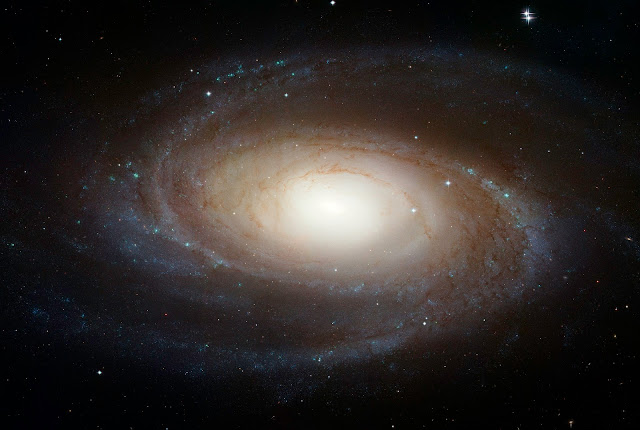The beautiful galaxy Messier 81 is tilted at an oblique angle on to our line of sight, giving a "birds-eye view" of the spiral structure. The galaxy is similar to our Milky Way, but our favourable view provides a better picture of the typical architecture of spiral galaxies. Though the galaxy is 11.6 million light-years away, the vision of the NASA/ESA Hubble Space Telescope is so sharp that it can resolve individual stars, along with open star clusters, globular star clusters, and even glowing regions of fluorescent gas.
The spiral arms, which wind all the way down into the nucleus, are made up of young, bluish, hot stars formed in the past few million years. They also host a population of stars formed in an episode of star formation that started about 600 million years ago. The greenish regions are dense areas of bright star formation. The ultraviolet light from hot young stars are fluorescing the surrounding clouds of hydrogen gas. A number of sinuous dust lanes also wind all the way into the nucleus of Messier 81.
The galaxy's central bulge contains much older, redder stars. It is significantly larger than the Milky Way's bulge. The central black hole is 70 million solar masses, or 15 times the mass of the Milky Way's black hole. Previous Hubble research shows that the size of the central black hole in a galaxy is proportional to the mass of a galaxy's bulge.
Messier 81 may be undergoing a surge of star formation along the spiral arms due to a close encounter it may have had with its nearby spiral galaxy NGC 3077 and a nearby starburst galaxy (Messier 82) about 300 million years ago. Astronomers plan to use the Hubble image to study the star formation history of the galaxy and how this history relates to the neutron stars and black holes seen in X-ray observations of Messier 81 with NASA's Chandra X-ray Observatory.
Messier 81 is one of the brightest galaxies that can be seen from the Earth. It is high in the northern sky in the constellation Ursa Major, the Great Bear. At an apparent magnitude of 6.8 it is just at the limit of naked-eye visibility. The galaxy's angular size is about the same as that of the Full Moon.
Image Credit: NASA, ESA and the Hubble Heritage Team STScI/AURA), A. Zezas and J. Huchra (Harvard-Smithsonian Center for Astrophysics)
Explanation from: https://www.spacetelescope.org/news/heic0710/




I like your`s channel.
ReplyDelete